ISSN ONLINE(2319-8753)PRINT(2347-6710)
ISSN ONLINE(2319-8753)PRINT(2347-6710)
U. N. Puntambekar1^, G. S. Grewal2, P. B. Joshi3 and P. Sampathkumaran4
|
| Related article at Pubmed, Scholar Google |
Visit for more related articles at International Journal of Innovative Research in Science, Engineering and Technology
In this investigation plasma nitriding has been carried-out to enhance surface related properties of steel components. The hardened case in these components comprise of a compound (white) layer on top followed by a diffusion zone underneath it. The increase in hardness and strength at the surface, yield improvement in fatigue life. However, increase in thickness of the compound layer beyond a certain critical reduces the fatigue life of the base material. Hence, it is desirable to have close control on the process to limit the formation of excessively thick compound layer. The data related to increased fatigue life of various low alloy steels is available in the published literature, but the effect of thickness of compound layer on fatigue life could not be cited in literature. Hence, the present work focuses on this issue. This paper discusses the effect of plasma nitriding and the thickness of compound layer in particular, for the En-24 steel. The experiments were carried-out on steel rod samples which were plasma nitrided with formation of varying amount of thickness of compound white layer and maintaining diffusion layer depth the same. The characterization of samples was done in respect of chemical composition, microstructure & micro-hardness. The rotating bending fatigue tests on plasma nitrided samples were conducted at various stress levels to plot S-N curves. Based on the fatigue test results, modification factors for stress & life-cycles were established. The data indicate that the fatigue life of samples increases up to a certain thickness of compound layer and then decreases.
Keywords |
| Fatigue, plasma nitriding, compound layer, low-alloy steel |
INTRODUCTION |
| The plasma nitriding is one of the thermo-chemical processes used to harden the surface of steel. In this process, nitrogen diffuses from the surface, similar to other nitriding processes, and forms various nitrides. The type & concentration of nitrides formed depends upon the gas composition, temperature & duration of nitriding. There are two important layers formed on the surface i.e. a compound layer at the surface and a diffusion zone beneath it, extending towards the core. The composition, hardness, strength and residual stress level of the region from surface to core vary continuously & widely. There is a vast difference in the levels of properties of these local regions. One of the key advantages of the plasma nitriding process is the attainment of uniformity of the surface properties and possible control over it through the process parameters. Similar to other nitriding processes, plasma nitriding also enhances the surface related properties such as wear & erosion resistance as well as fretting & plain fatigue strength ([1], [2]). |
| It is known that the fatigue cracks are by and large initiated at the surface and the fatigue strength of component depends on the surface quality. In general, the fatigue strength depends upon the strength level of surface layer. There are three ways in which the surface treatment influences fatigue strength; firstly, by affecting the intrinsic fatigue strength of material at the surface, secondly by introducing or removing residual stresses in the surface layers and thirdly, by introducing or removing irregularities in the surface which act as stress raisers [3]. Plasma nitriding enhances fatigue strength by first two mechanisms stated above. Apart from this, extent of increase in fatigue strength also depends upon the factors like, thickness of the case, ratio of case to core area, residual stress levels at case, etc. Substantial data is available on the fatigue strength of plasma nitrided steels. Likewise, relationships have also been established between the case properties and fatigue strength [10]. |
| The effect of nitriding on fatigue life has been studied for AISI 1045 [4], B-Mn steel [5], tool steel ([6],[8],[11]), constructional steel ([7],[14]), Cr-Ni-Mo steel ([9],[13]), AISI 4340 steel [16], AISI 4140 steel ([12],[19],[20],[23]), En-40 B steel ([11],[22]), Cr-Mo steel [17], Cr-Mo-V steel [10], AISI 304 steel [18], & SA 645 steel [15]. The study indicate an improvement in fatigue life in most of the steels ([4], [5], [7]-[17], [20]-[23]), whereas an adverse effect has been observed in tool steel [6] & AISI 304 [8]. It has been reported that the plasma nitriding improves the fatigue strength of AISI 4140 steel and increases the fatigue limit depending on the surface hardness and the case depth [12]. Studies on the effect of plasma nitriding on repair process of fatigue damaged AISI 4140 steel show that the process applied to untreated specimens improves the fatigue life of the specimens that were plasma nitrided. However, for the nitrided specimens, a significant improvement in the fatigue life has not been observed because of the compound layer on the surface prevents the diffusion to occur during the second nitriding [19]. The improvement up to 90% in fatigue strength of base material has been achieved through plasma nitriding for AISI 4340 steel [16]. However, it appears that the effect of variation in thickness of the compound layer (with same diffusion layer thickness) has not been reported in the literature. In view of the above, a study has been undertaken to determine the effect of varying thickness of compound layer on fatigue strength of En-24 steel. The steel selected is the most commonly used material for the shaft applications. This paper describes the details of this study. The investigation was conducted based on statistical design of experiments. The effect of the various treatments has been systematically studied using various statistical inferential techniques. Basquin type power law relationship for alternating stress amplitude versus cycles to failure has been derived. Based on these plots, the surface treatment modification factors have been arrived at. Further, the results obtained are correlated with the underlying physical processes associated with the various treatments studied. |
EXPERIMENTAL & ANALYTICAL METHODOLOGY |
| A. Experimental En-24 grade low-alloy steel, which is a most commonly used shafting material, has been selected for this study. A coil of hot-rolled wire-rod of 20 mm diameter was obtained from steel plant. Subsequently wire drawing was done to obtain scale and decarburization free rods of 18.7 mm diameter. The rod material had an average austenitic grain size No. 6 (as per ASTM E – 115) and controlled non-metallic inclusions index equal to 1.5 as per IS: 4163 – 2004. The composition analysed is shown in Table 1. Figure 1 gives the schematic of the test sample used for fatigue testing, wherein the gauge diameter of 12 mm contains a machined, semi-circular notch of depth 1.5 mm and root radius of 1 mm. This translates into a stress concentration factor of 2, as computed using analytical elastic stress analysis theory. The normalized wire-rods were given hardening & tempering heat-treatment by preheating at 500˚C,austenitising at 855˚C, quenching in oil & finally tempering at 520˚C to obtain hardness of 32±2 HRC ( 320 HV). The mechanical properties measured in respect of hardened & tempered wire rods are shown in Table 2. |
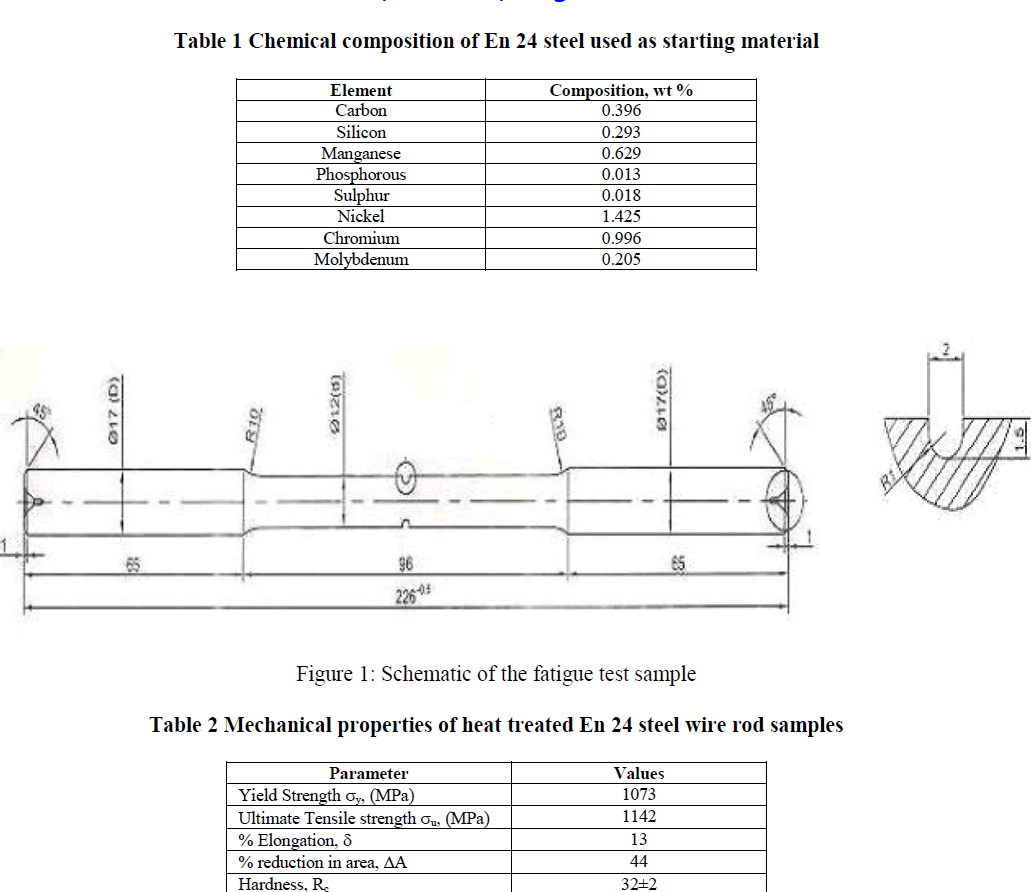 |
| The machined fatigue test samples were subjected to plasma nitriding to obtain three different thicknesses (categories) of compound (white) layer i.e. without compound layer (category-1), with compound layer thickness of up to 10 microns (category-2) and thickness of > 10 microns (category-3). For all these categories of samples, the nitrided layer thickness was around 400 microns. The surface hardness of the samples after nitriding varied depending on the thickness of compound layer. The mIcrohardness profiles were measured and plotted for the nitrided samples. The surface roughness (Ra, m) of the samples subjected to fatigue test was around 0.68 for base material (control) and 0.49 for plasma- nitrided samples. The rotating bending fatigue tests were conducted, using a R. R. Moore type rotating bending fatigue testing machine. The samples without surface treatment (Control category), and surface-treated categories (3 nos. each) were evaluated for fatigue life. Six stress levels with four replications were selected for fatigue evaluation. |
| B. Modeling of Fatigue Data |
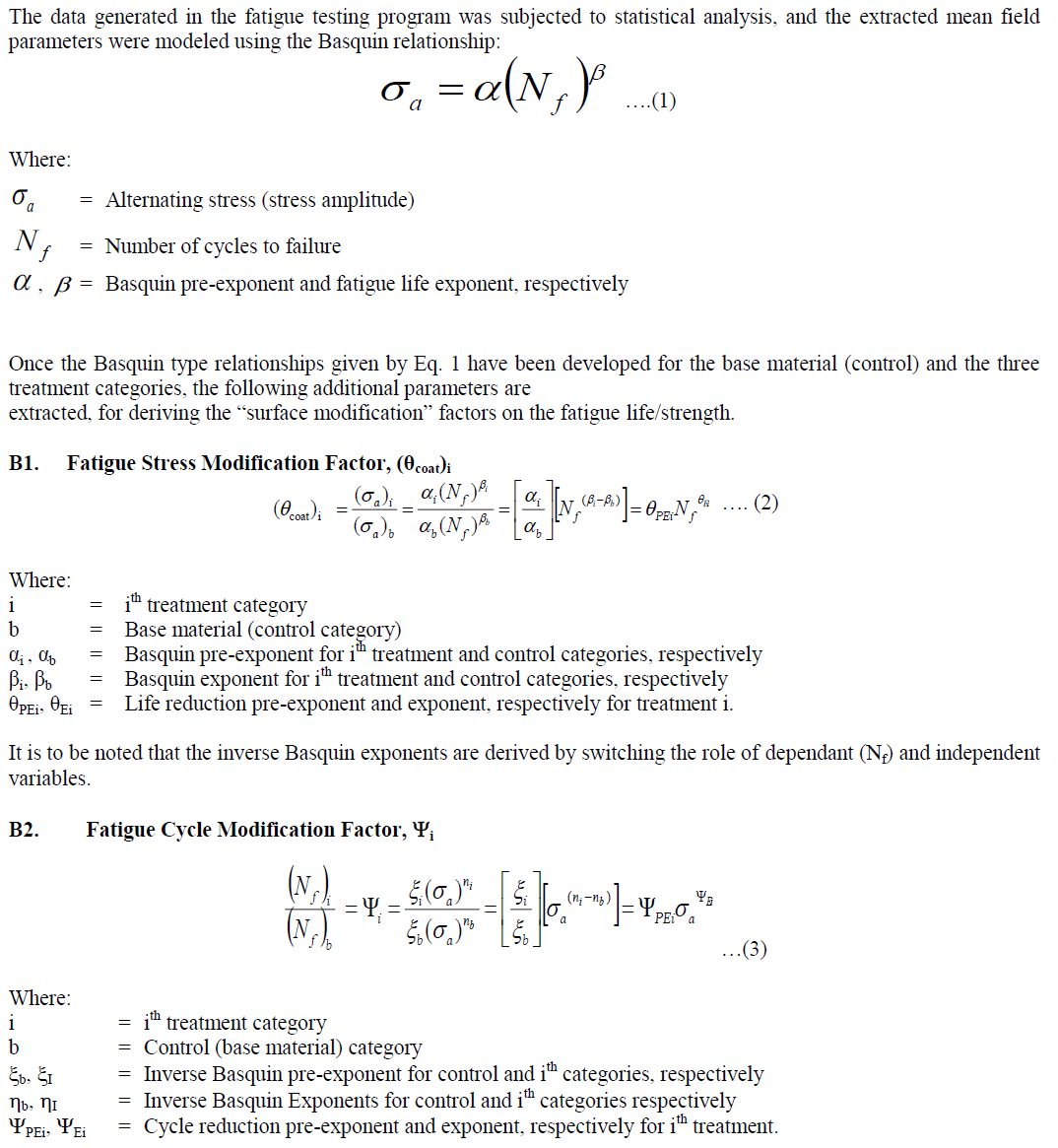 |
| In the present work, the effect of surface modification is elucidated by deriving the Fatigue Stress Modification Factor (FSMF), (θcoat)i given by Eq. (2). The data have been discussed based on the results presented in the following section. |
RESULTS & DISCUSSION |
| The chemical composition of the material used matches well with the standard specification, and does not contain any impurities which can otherwise lead to lower fatigue life. The Micro hardness profile (Figure 2) indicates that total case depth (400m, considering 400 HV as threshold for a core hardness of 320HV) is almost similar for all the three categories. The sharp decrease of hardness in the samples with higher compound layer thickness (>10 m) as against smooth curves for other two categories, is as expected. |
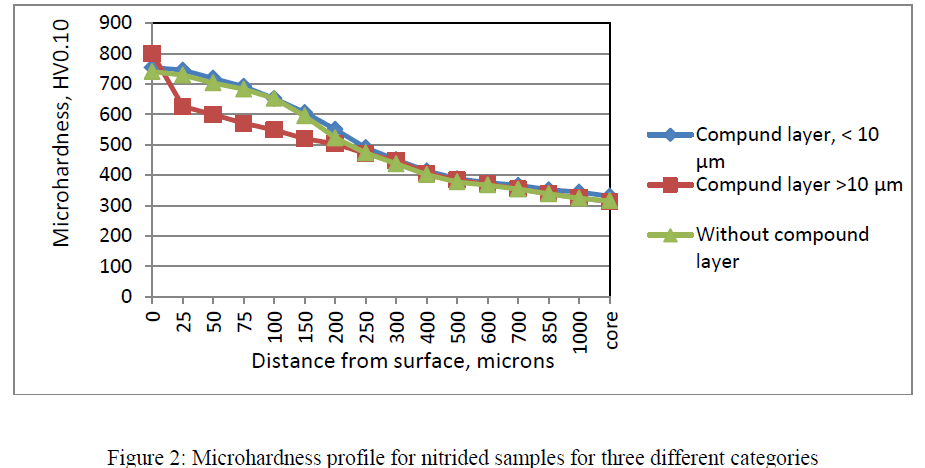 |
| The results obtained in terms of the number of cycles to failure at any given alternating stress level for the untreated samples (control) as well as for the three categories of plasma nitrided (with compound layer > 10 m, compound layer < 10 m, & free from compound layer) samples are shown in Basquin plots given in Fig.3 (a) to (d). In these plots, the predictions of the derived Basquin relationships as per Eq. (1) are superimposed on the experiment data. Based on the results obtained, the Basquin pre-exponents and post-exponents for control and various treatment levels are compiled in Table 3, below |
 |
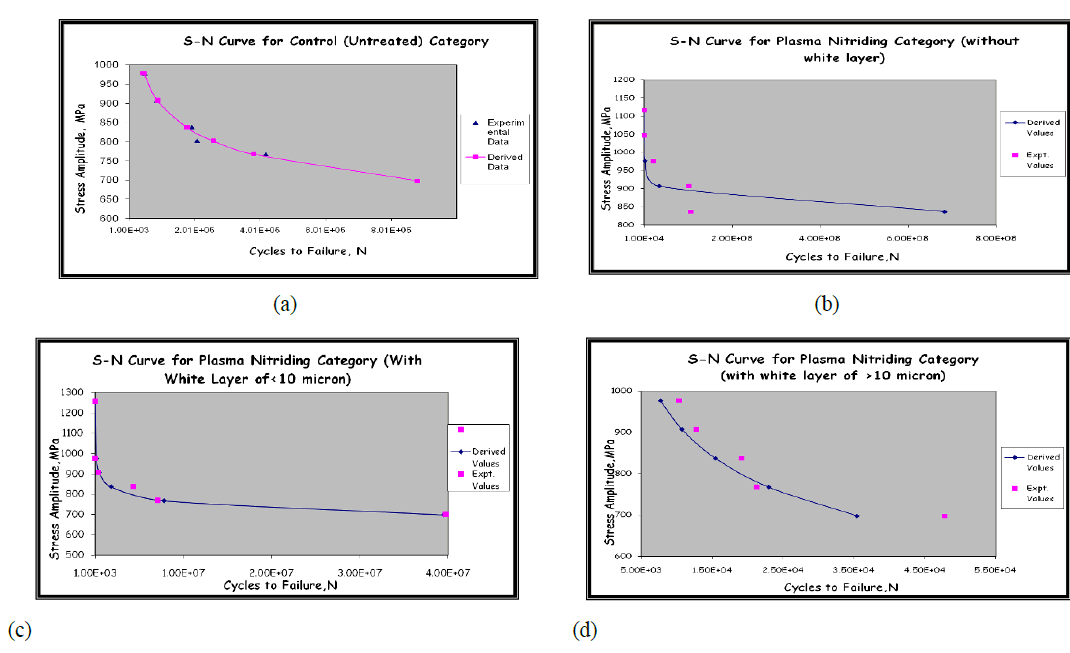 |
| Figure 3: Basquin type plots for alternating stress versus cycles to failure for: (a) control category, (b) plasma nitriding category without compound layer, (c) plasma nitriding category with compound layer of less than 10m thickness and (d) plasma nitriding category with compound layer of greater than 10m thickness. To determine the effect of the nitriding on fatigue life, the Fatigue Stress Modification Factor (FSMF), (θcoat)i are derived, using Eq. (2), and the Basquin coefficients derived as per Table 1. The superposed Fatigue Stress Modification Factor (FSMF) for the three Plasma Nitrided categories is presented in Fig. 4. |
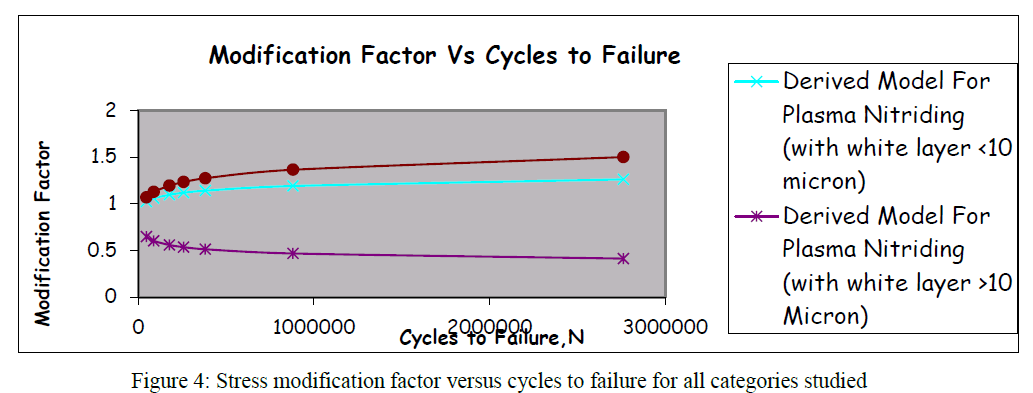 |
| It is seen from these plots that the severest stress reduction occurs for the plasma nitrided category with compound layer greater than 10m. For this category, the Fatigue Stress Modification Factors (FSMFs), (θcoat)i are fractional (less than one), and undergo a monotonic decrease with an increase in the number of cycles to failures. In other words, if one were to plot a superposition of the Basquin plots for this category (with thickness of compound layer greater than 10 microns) with reference to the control - untreated category, the Basquin plots will be translated downwards - parallel to the alternating stress axis - and leftwards - parallel to the “number of cycles to failure” axis. On the other hand, for the plasma nitrided categories, with compound layer less than 10 m as well as with “absence of compound layer”, the Fatigue Stress Modification Factors (FSMFs), (θcoat)i are greater than one, with the plasma nitrided category without compound layer showing the highest increase in the stress modification factor. The presence of compound layer less than 10m is seen to degrade the fatigue resistance as compared to the fatigue resistance for the plasma nitrided category without the compound layer. Thus, plasma nitriding (without compound layer as well as plasma nitriding with compound layer lower than 10 m) increases fatigue life by delaying the onset of fatigue crack nucleation and also possibly the “fatigue crack growth rate” – at least – through the nitrided layer. The difference in the fatigue strength of compound layer greater than 10 micron and less than10 micron, respectively, is essentially associated with interaction effects of compound layer thickness with the state of residual stress. It is known that compound layer tends to have principal residual and octahedral normal stresses in the tensile mode. Further, the probability of fatigue crack nucleation is directly proportional to the volume of compound layer. Thus, for larger thickness of compound layer, the probability of crack nucleation will be higher and will decrease as the thickness of the compound layer reduces. At a critical threshold value of the thickness, the probability of crack nucleation in the diffusion zone can easily become larger than in the compound layer. Similarly, below a threshold thickness of compound layer the residual stress can switch to the compressive mode leading to enhanced fatigue strength. However, more work is required to be done to verify these conjectures, by conducting a systematic experimental investigations and analysis of residual stresses in the compound layer as well as quantum chemical calculations using a quantum chemistry package. Thus, present investigation reveals that the Plasma Nitriding - in the presence of compound layer less than 10m - does not degrade fatigue life/strength but, in-fact, results in its increase. In other words, in contrast to the commonly held notion that the presence of compound layer (in any thickness) will degrade the fatigue life, the present study shows that this is not completely true. The exact effect of the compound layer on the fatigue life depends on two thickness regimes of the layer. Thus, when the compound layer thickness is greater than 10m, the fatigue life is markedly degraded. On the other hand, for compound layer thicknesses less than 10 m, the effect on fatigue life is positive, albeit a little lower than the fatigue life of plasma nitriding coating without any compound layer. The photo macrographs of the fractured surfaces of typical control, plasma- nitrided (without compound layer) and plasma nitrided (with compound layer) are shown in Fig. 5. |
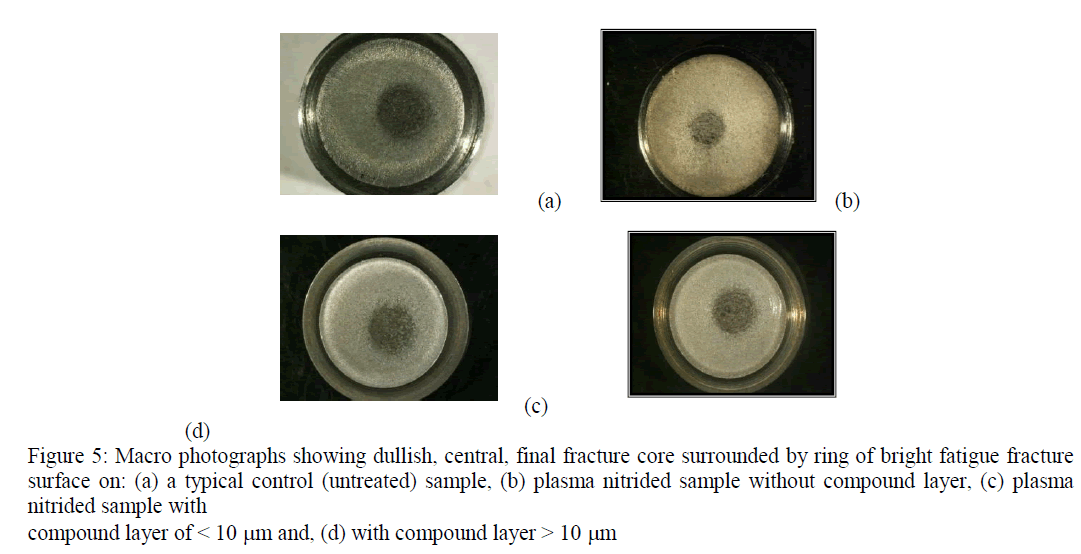 |
| It is observed that the central - final fracture core is symmetrical with respect to the axis of the test sample. It is also noticed that the outer circumferential of the sample surface is characterized by the absence of any significant visually apparent texture or asymmetry which can be associated with a site for gross fatigue initiation. A “Fish Eye” type crack initiation ([5],[9],[10],[13]-[16],[21]-[23]) which normally correlates with the presence of non-metallic inclusions ([14]-[16]) has not been observed on the fatigue fractured surface; probably due to close control of the properties of the starting material used. Figures 6(a) to (c) show the photomicrographs of the plasma- nitrided fatigue test samples without compound layer, with compound layer less than 10 m as well as with compound layer greater than 10m. The light micro-photographs show plasma nitrided surface without compound layer, with less than 10 m thickness, and with greater than 10 m thickness |
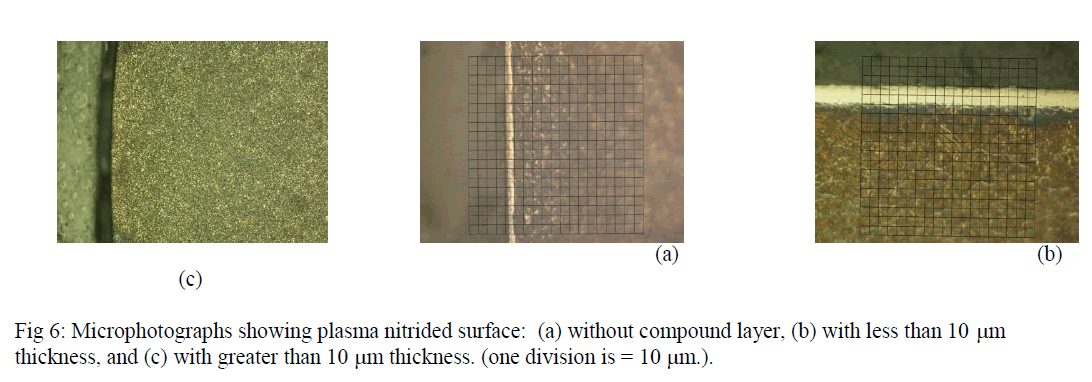 |
CONCLUSIONS |
| Based on the results obtained, the following conclusions drawn are as follows: |
 |
ACKNOWLEDGEMENT |
| We are indebted to Ministry of Power, Government of India for funding the research project under its RSOP scheme, administered through Central Power Research Institute (CPRI). We are thankful to CPRI for its support as a nodal agency for co-ordination of this research project. We profusely thank the management of Electrical Research & Development Association (ERDA) for providing infrastructure facilities for setting up the fatigue laboratory as well as for providing all required support during the research program. Our thanks also go out to all our colleagues in ERDA who extended their timely help, as and when required. |
References |
|